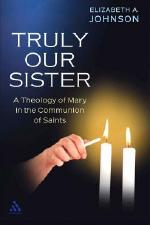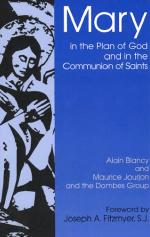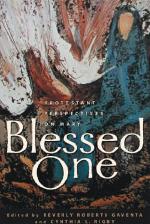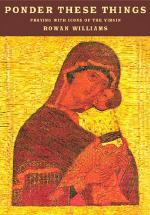|
Issue Date: May 23, 2003 Reinterpreting Mary for today
Reviewed by SALLY CUNNEEN If Mary has seemed responsible for divisions among Christians in the past, the four books reviewed here reveal her as a surprising force for unity, though one with a love of diversity. The ability to look back through two millennia of tradition and forward to a new and vital Christianity is palpable in all of them. Karl Rahner said that Mariology has “a great deal to do if it wants to have an image of Mary that will really be true for the religious existence of women. ... It is an image that can perhaps be produced authentically only by women, by women theologians.” His prophecy proves true in the appearance of Truly Our Sister, the long-awaited book by theologian Elizabeth A. Johnson, author of She Who Is and Friends of God and Prophets. Lucidly written, logically structured, and enriched by her vast reading and 20 years of teaching and writing about Mary, the book develops a solid post-Vatican II theology that is both critical of and deeply steeped in the tradition it opens up so creatively. It should be read not only by theologians but by all Christians who have often inherited a distorted view of Mary’s place with us and in the church. Johnson is up front about her aim: to “articulate a theology of Mary that will promote the flourishing of women and thereby all the relationships and communities of which they are a part.” This includes the church, of course, and makes the book necessary reading for men as for women. Before she develops her theology, Johnson counsels against two “dead ends”: Mary as the ideal woman and Mary as the maternal face of God. Though she recognizes their beauty, logic and use for male interpreters through the ages, sharing lovely citations from Ambrose and Augustine in particular -- she relentlessly if respectfully explores the often subtle harm they have done, drawing on the insights of both feminist and liberation theology to criticize earlier distortions. Her analysis of the limits even of Lumen Gentium are significant. Though the document recognizes Mary as the model of the church in faith and action, it reveals the gender dualism that frames its analysis by not extending that “action” to women’s governing, preaching or administering the sacraments. Such gender dualism, distorting human development, also contributes to the common, idolatrous assumption that God is masculine. Next she boldly divides the first 2,000 years of thought about Mary into two parts: first, as a member of the communion of saints; second, as a woman alone. At Vatican II the attempt was made to return Mary to the church and Johnson explains in detail the significance of this decision. Along with Paul VI’s apostolic letter Marialis Cultus -- in which he called Mary “truly our sister” -- it forms the baseline for Johnson’s own theology, focusing on Mary’s humanity. One of the richest sections of the book fills in the context of the actual world in which the mother of Jesus lived. First the political-economic realities of her life are made plain, then the social-cultural influences. A member of the peasant-artisan class, Mary lacked both status and formal education and worked hard in a communal setting; there was no nuclear Holy Family. Johnson explains the Judaism of the period in detail, drawing on images and actions related to Mary’s life. I finally got a clear picture of the appearance of the temple in Jerusalem and what went on there. It was also useful to be reminded that neither Jesus -- a lay prophet, not a priest -- nor his mother ever repudiated their religion. Within such a context, Johnson provides a commentary on Mary’s 13 appearances in the gospels, a complex mosaic that forms the last third of the book. Of course, this cannot be a biography, since the evangelists tell us little and differ in their accounts, but Johnson revisits each Marian scene and teases out possibilities that give her a richer, deeper identity. Mary’s virginity is treated extensively, stressing the difference between biblical and later interpretations, and suggesting that “divine and human fatherhood are not necessarily mutually exclusive.” Regarding her sinlessness, Johnson observes fruitfully that the Immaculate Conception is really about the presence of grace, not the absence of sin. She reexamines the birthing at the time to remove the sentimentality that has grown up around the Nativity. “Real blood was shed at this delivery, by a poor woman of peasant society far from home, laboring in childbirth for the first time. And it was holy.” Marcan passages (3:20-21 and 31-35) that seem to suggest Mary’s lack of faith in Jesus might be a good mother’s attempt to shield her son from danger. As this image of Mary grows, it takes on the overall appearance of the woman who, in response to her cousin Elizabeth’s prophetic greeting, delivered her radical Magnificat, in which she both embodies and preaches God’s mercy for the oppressed. Her joyous, prophetic outburst of faith indicts not only power structures in the world, but in the church as well, where “the mighty still occupy their thrones.” Stressing the companionship model of the living and the dead in her conclusion, Johnson places Mary, no longer solitary, within the communion of saints. Truly Our Sister encourages and assists us to “let God have her own maternal face” and allow “Miriam the Galilean woman to rejoin the community of disciples.” The 40 French and Swiss theologians who constitute the Dombes Group, evenly divided between Protestants and Catholics, came to many of the same conclusions as Johnson. The results of their deliberations on Mary, from 1991-97, are published here in English for the first time in Mary in the Plan of God and in the Communion of Saints. Biblical studies have obviously provided Catholic and Protestant scholars solid ground on which to make congenial contacts and reach conclusions unimaginable a few decades ago. What is unusual about this highly regarded group, which has been meeting since 1937, is their pastoral outreach and their avowed hope of unifying the churches. This well-written and useful document with numbered paragraphs and excellent, informative notes gives a careful and honest presentation of both Catholic and Protestant positions. The two participant-authors present their findings in four sections: the lessons of history, the scriptural texts, disputed questions about Mary, and their suggestions for convergence. Each is concise and informative, but I found particularly valuable the summary of Marian views by Luther, Calvin, Zwingli and later reformers, set within a historical context. Although there was no woman in the group, Dombes participants have clearly been reading women theologians: The scripture section insists that Mary should not be considered “as a woman separated from other human beings nor as a model of passive submission … or as a symbol of ideal femininity that would imply some scorn of sexuality and fleshly generation.” The disputed questions were four. How much did Mary “cooperate” in salvation? Was she a perpetual virgin? What about the dogmas of the Immaculate Conception and the Assumption? And finally, can Protestants pray to Mary? After briefly presenting the traditional attitudes of Catholic and Protestant theologians, they conclude surprisingly that, after careful analysis and prioritizing, they “no longer consider the described differences such as to separate us.” An excellent guide for study groups, this book should be widely available for those who might want to take up the invitation to unity it offers, since so little is being done from the top down. The lack of attention to Mary in American Protestant theology, evident even 10 years ago, is clearly reversed in Blessed One, a readable collection assembled by Beverly Roberts Gaventa and Cynthia L. Rigby. They echo the findings of the Dombes Group, declaring, “The absence of Mary not only cuts Protestants off from Catholic and Orthodox Christians; it cuts us off from the fullness of our own tradition. We have neither blessed Mary nor allowed her to bless us.” Twelve Protestant scholars were asked to respond to the following questions: Who is Mary? What does she teach us about ourselves? What does she teach us about God? They wrestle with the paradoxes and mysteries long confronted by Catholics: virgin and mother, human and mother of God. Collaborative biblical studies among Protestant and Catholic scholars and the revised image of Mary in feminist and liberationist theology have clearly influenced their responses. Any image of Mary in the reformed tradition must, of course, be rooted in the gospels, but in Blessed One, academic research is undertaken as a fresh voyage of discovery. Theologian Daniel L. Migliore sees in Mary’s actions and words a courageous response to God’s will that places her alongside Abraham and Moses. Like Oblate Fr. Tissa Balasuriya, Sri Lankan theologian, he points out that her Magnificat is more disturbing to most Christians than her comforting role as Queen of Heaven. Migliore sees the presence of Mary and the beloved disciple at the foot of the cross as “powerful biblical authorization of the ordination of women and men to ministry.” He finds Mary (as Newman did) an exemplar of the church precisely because she had to continue to learn and interpret the word to which she remained faithful. The theme that the church as a whole is better served by a Mary who is not idealized, sinless or perfect is developed by theological ethicist Nancy J. Duff, who suggests that perfection undercuts the significance of Jesus’ incarnation into a world of sinners. Using Mary’s perfection to represent the church can make us forget that the church, too, is sinful. The theme of Mary’s “pondering,” repeated over and over in Luke’s gospel, reminds Joel B. Green that “faithful hearing, the sort that leads to faithful doing ... involves the struggle of interpretation.” Luke is inviting all of us to follow Mary’s lead in the constant need to think how our faith should be embodied in our lives. Other essays investigate Mary’s role in the gospels as disciple, prophet and one of us, extending its meaning beyond earlier Lutheran or Calvinist beliefs. Inspired by her own experience and by the value of “maternal thinking” explored by philosopher Sara Rudi, Bonnie J. Miller-McLemore sees Mary’s motherhood as itself a difficult intellectual discipleship. In an original analysis of the nature of Mary’s “choice” when faced with God’s proposal, Cynthia L. Rigby calls it a much deeper response, more like “participation,” which she describes through comparison with creative artistry. Inevitably, the essays in Blessed One are uneven, but most of them would be as illuminating to Catholics as to Protestants. The greater liberty exercised by individual writers than that allowed to the members of the Domes Group makes the book an attractive invitation to further dialogue on Mary as a central key to understanding the incarnation today. In Ponder These Things, Archbishop of Canterbury Rowan Williams introduces us to a totally different kind of dialogue about her. The book is based on talks he gave during an annual diocesan pilgrimage to the shrine of Walsingham (destroyed by Henry VIII for its idolatrous Catholicism in 1538 and rebuilt in the 20th century) designed to help us cross new frontiers in our relationship with God. His means of guiding us is to share reflections on three traditional Orthodox icons of the Virgin and one ancient legend, for “imagining Mary in words and pictures has always been one of the most powerful ways of imagining the church, and so of imagining ourselves freshly.” In easy, conversational style Williams helps us see in these icons that what appears to be familiar, a mother and a baby, invites us to contemplate what is almost too strange to grasp. In the Mother of God who points the way (the Hodegetria), Mary’s hand directs us to her child cradled in her other arm. But the motion of this icon, like the next one, the Virgin of Loving Kindness (Eleousa) is circular. Our eye moves to the child who not only looks at his mother, but nuzzles her cheek and presses against her, while she looks directly and sadly at us. She urges us to see her son, yet his glance tells us that she is the object of his love, “and for her to look to Christ is for her to look at herself truthfully -- as loved by him.” Like the rest of us. Williams is equally evocative in his treatment of Our Lady of the Sign, in which the Christ child sits in a medallion within Mary’s breast as she raises her hands in the traditional pose of an orant. It is an image of God’s hiddenness within the church and ourselves, Williams suggests, and he encourages us to search for it and trust it, no matter how it may contradict our expectations. The intuitive Eastern tradition in which these icons were written sees their place as part of the process by which the Holy Spirit leads us to the truth of Christ, and hence to our healing and restoration. Williams uses this same approach today, thoughtfully suggesting the tenacious, fierce power of God’s love for us through the medium of these holy images. This small, lovely book asks to be read and reread. It would also make an excellent gift. Sally Cunneen, cofounder of Cross Currents, the international ecumenical quarterly, is the author of four books, including In Search of Mary: the Woman and the Symbol. Her e-mail address is SCunn24219@aol.com National Catholic Reporter, May 23, 2003 |



